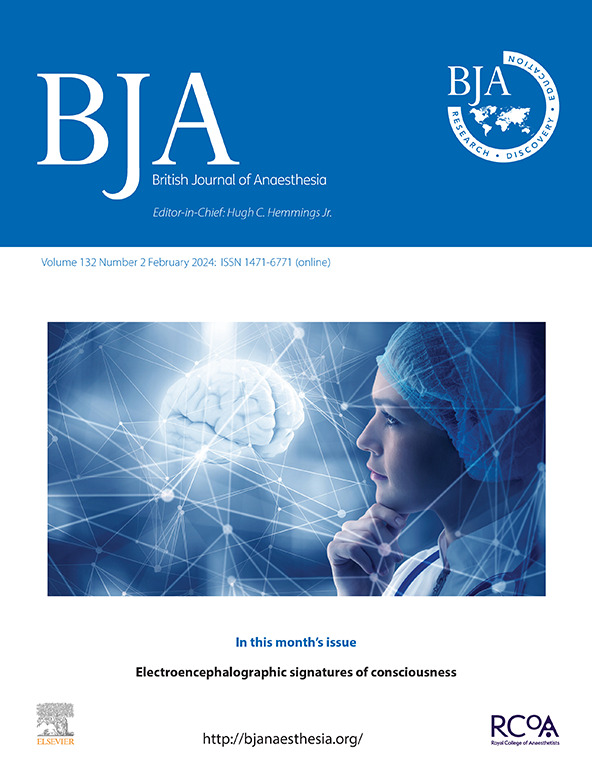Hydroxocobalamin for vasoplegia in cardiac surgery: a retrospective cohort analysis.
IF 9.1
1区 医学
Q1 ANESTHESIOLOGY
引用次数: 0
Abstract
BACKGROUND Vasoplegia during cardiac surgery is common and associated with perioperative mortality. Hydroxocobalamin is a catecholamine-sparing approach for treating vasoplegia. However, there is currently limited evidence to inform its use. METHODS We conducted a single-centre retrospective propensity-matched cohort study of patients who developed vasoplegia after cardiopulmonary bypass. Our primary outcome was vasopressor requirement, expressed as norepinephrine equivalents (NEE), at 1, 4, 24, and 48 h after treatment. Our secondary outcome was a collapsed composite of in-hospital complications comprising stroke, sternal wound infection, mesenteric ischaemia, renal failure, and death. RESULTS We identified 2727 (11%) patients with vasoplegia from 2018 to 2024. The final analysis cohort included 229 matched pairs. Hydroxocobalamin administration was associated with a significant reduction in median NEE infusion rates of -0.04 (95% confidence interval [CI]: -0.07 to -0.02; P=0.008) μg kg-1 min-1 at 1 h, -0.05 (95% CI: -0.07 to -0.02; P<0.001) μg kg-1 min-1 at 4 h, and -0.04 (95% CI: -0.06 to -0.02; P=0.004) μg kg-1 min-1 at 24 h, but not at 48 h, -0.02 (95% CI: -0.05 to 0.0; P=0.220) μg kg-1 min-1. Over the initial 24 h, hydroxocobalamin reduced NEE by 14% compared with the reference group. The risk of in-hospital complications was similar in each group (odds ratio: 1.06; 95% CI: 0.74-1.54; P=0.745). CONCLUSIONS Hydroxocobalamin administration was associated with reduced vasopressor requirement over 24 h, but not thereafter. Robust trials are needed to determine whether this relationship is causal, and whether a reduction in vasopressor use improves substantive clinical outcomes.羟钴胺素治疗心脏外科血管截瘫:回顾性队列分析。
背景:心脏手术期间的静脉截瘫很常见,并与围手术期死亡率相关。羟钴胺素是一种节省儿茶酚胺的治疗血管麻痹的方法。然而,目前关于其使用的证据有限。方法:我们对体外循环术后血管截瘫患者进行了单中心回顾性倾向匹配队列研究。我们的主要终点是治疗后1、4、24和48小时的血管加压素需要量,以去甲肾上腺素当量(NEE)表示。我们的次要结局是院内并发症的崩溃组合,包括中风、胸骨伤口感染、肠系膜缺血、肾功能衰竭和死亡。结果2018年至2024年,共发现2727例(11%)血管截瘫患者。最终的分析队列包括229对匹配的配对。羟钴胺素给药与NEE中位输注率显著降低-0.04相关(95%可信区间[CI]: -0.07至-0.02;P=0.008) μ kg-1 min-1, -0.05 (95% CI: -0.07 ~ -0.02;P<0.001), -0.04 (95% CI: -0.06 ~ -0.02;P=0.004) μ kg-1 min-1,但在48 h时没有,-0.02 (95% CI: -0.05 ~ 0.0;P=0.220) μg kg-1 min-1。在最初的24小时内,与对照组相比,羟钴胺素使NEE减少了14%。两组住院并发症发生风险相似(优势比:1.06;95% ci: 0.74-1.54;P = 0.745)。结论羟基钴胺素可降低24 h内血管加压素的需要量,但此后则无关。需要强有力的试验来确定这种关系是否存在因果关系,以及减少血管加压剂的使用是否能改善实质性的临床结果。
本文章由计算机程序翻译,如有差异,请以英文原文为准。
求助全文
约1分钟内获得全文
求助全文
来源期刊
CiteScore
13.50
自引率
7.10%
发文量
488
审稿时长
27 days
期刊介绍:
The British Journal of Anaesthesia (BJA) is a prestigious publication that covers a wide range of topics in anaesthesia, critical care medicine, pain medicine, and perioperative medicine. It aims to disseminate high-impact original research, spanning fundamental, translational, and clinical sciences, as well as clinical practice, technology, education, and training. Additionally, the journal features review articles, notable case reports, correspondence, and special articles that appeal to a broader audience.
The BJA is proudly associated with The Royal College of Anaesthetists, The College of Anaesthesiologists of Ireland, and The Hong Kong College of Anaesthesiologists. This partnership provides members of these esteemed institutions with access to not only the BJA but also its sister publication, BJA Education. It is essential to note that both journals maintain their editorial independence.
Overall, the BJA offers a diverse and comprehensive platform for anaesthetists, critical care physicians, pain specialists, and perioperative medicine practitioners to contribute and stay updated with the latest advancements in their respective fields.

 求助内容:
求助内容: 应助结果提醒方式:
应助结果提醒方式:


